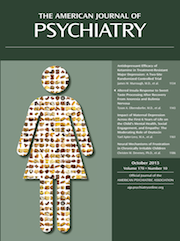In This Issue

Intravenous ketamine administered to depressed patients who had not responded to at least three previous antidepressants improved depression in 64% of patients 24 hours after a single dose, compared to 28% of patients who received the anesthetic midazolam. The 73 patients studied by Murrough et al. (p. Original article: 1134) were carefully screened to exclude those with substance abuse, psychotic illness, suicide risk, and unstable medical conditions. Dissociative symptoms, such as feeling outside one’s body, occurred in 17% of the ketamine group, and blood pressure changes in two patients required termination of the infusion. Depression scores did not differ between treatment groups 7 days after the infusion. Ketamine is not ready for clinical use, states Rush in an editorial (p. Original article: 1079), but it is a promising lead for new therapeutic development.
Oxytocin and Mental Illness
Oxytocin’s influence on social behavior extends to the pathophysiology and treatment of psychiatric disorders. Apter-Levy et al. (CME, p. Original article: 1161) discovered that low salivary oxytocin levels in chronically depressed mothers and their families were associated with the GG genotype for an oxytocin receptor gene (OXTR) variant in the mother. The GG genotype was overrepresented in depressed mothers and their children, but the children’s high psychopathology levels were buffered by the presence of at least one A allele. Bertsch et al. (p. Original article: 1169) tested intranasal oxytocin as a treatment for social threat hypersensitivity. While viewing pictures of angry faces, untreated women with borderline personality disorder had more changes in visual fixation and greater amygdala activation than healthy women, but patients given oxytocin had normal responses. Impaired social cognition is common to many psychiatric disorders, notes Hollander in an editorial (p. Original article: 1086), and specific domains, such as social reward and eye gaze, may make useful research targets for oxytocin.
Appreciation of abnormal brain activation to food in anorexia nervosa or bulimia nervosa, even after recovery, may help patients understand its pathological mechanisms. Oberndorfer et al. (p. Original article: 1143) demonstrated that in response to the taste of sugar, the brain’s higher center for taste processing, the anterior insula, activated less in women recovered from anorexia nervosa than in healthy women. Conversely, women recovered from bulimia nervosa had exaggerated responses. An attenuated response to food might call for small meals throughout the day, whereas help to cope with excessive activation might combat purging. A study of brain structure by Frank et al. (CME, p. Original article: 1152) found associations between sweet taste and the volume of brain regions related to both taste and reward sensitivity in both anorexia nervosa and bulimia nervosa. In an editorial, Alonso-Alonso (p. Original article: 1082) distinguishes between “liking” and “wanting” food, noting that both healthy subjects and eating disorder patients considered the sweet taste to be pleasant but that the patients had higher sensitivity to it as a reward.
The behavioral responses to frustration in children with severe, chronic irritability are mirrored by abnormal neural responses. Deveney et al. (CME, p. Original article: 1186) report that brain regions implicated in emotion, spatial attention, and reward processing show less activation after negative feedback in frustrating situations among children with severe mood dysregulation than among healthy children. Children with severe mood dysregulation also exhibit difficulty in shifting attention. Ryan points out in an editorial (p. Original article: 1093) that the findings may apply to other disorders, since irritability spans multiple diagnoses.



